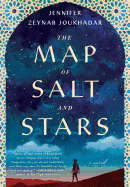
In 2011, in Manhattan, Nour's father dies, filling the 12-year-old Syrian American girl with grief and upending her world. In the mid-12th century, in Ceuta, on the North African coast, 16-year-old Rawiya leaves home with her beloved horse, Bauza, to see the world. In The Map of Salt and Stars, Jennifer Zeynab Joukhadar has woven these two lives together in remarkable journeys touched by fable and fraught with danger.
Nour's father, Baba, was an architect and a storyteller--that's how he untangled "the world's knots." Nour loved his stories, particularly the one about a mapmaker's apprentice; when his voice would tire, she'd finish for him. But after his burial, her voice "went into the earth with Baba, deep in the white bone of the earth." Her mother lost her words, too--"instead of talking, her tears watered everything in the apartment. That winter I found salt everywhere...." When spring came, those salt tears led her mapmaker mother, with Nour and her older sisters, Huda and Zahra, back to Syria, where everyone except Nour was born. Nour laments, "Now, thirty thousand feet above him, I am trying to untangle the knot he left in me.... But my words are wild country, and I don't have a map."
Three months later, living in Homs, Nour is at a disadvantage because she speaks little Arabic. She also has synesthesia, which literally colors her world, but also sets her apart. She often goes out to the fig tree in their garden to tell her favorite story to the fig's roots, imagining the vibrations of her voice traveling to Baba as she recounts the tale of Rawiya and al-Idrisi--"The one Baba told me every night. The one where they mapped the world." There has been unrest in the city; one night at dinner with Abu Sayeed, Baba's adopted brother, helicopter blades "pop black and purple" over their heads. A shrieking sound follows and the ceiling collapses. Dazed and bloody, they all make their way outside to rubble and chaos.
Rawiya's story begins with her desire to leave her village, to seek her fortune and save her family from poverty. One morning, by the fig tree next to the house, she saddles Bauza, takes the sling her father had made for her, and tells her mother she is going to the Fes market. Ten days later, disguised as a boy named Rami, she arrives in Fes, where she is dazzled by the rose- and saffron-colored houses, green minarets and the bite of pomegranates, the "sugar-song of dates." She is seeking the legendary mapmaker, Abu Abd Allah Muhammad al-Idrisi, with plans to apprentice herself to him. Unrecognized by her, he approaches "Rami" and agrees to tell her where to find him if she can answer three riddles. She does, he reveals himself, and takes her to Sicily to the palace of King Roger II of Palermo, his patron. There the duo, along with a new apprentice, Bakr, are charged with creating a map of the entire world. The expedition sets off for Asia Minor, and from the Anatolian coast, they enter the Levant and the Syrian province of the Seljuq Empire. Here, the tale of Rawiya and al-Idrisi begins to alternate with Nour's life as they begin parallel journeys that will eventually take them to Ceuta.
Nour's family leaves Homs after the shelling. Their papers and belongings fit into one burlap bag; Huda is badly injured. They drive to Jordan with Abu Sayeed, but find no succor, only a brief rest. They leave for Egypt, then Libya. They endure a sinking ferry and separation; for Nour and Zahra, a terrifying trip across Libya hidden in a refrigerated truck. The trek is not safe for Rawiya and al-Idrisi, either. Rawiya saves the caravan from a great white roc--the legendary bird of prey--with her prowess with the sling; later, they battle enormous snakes with mirrored scales. Human obstacles appear, like the Almohad fighters looking to capture a certain mapmaker.
Nour is "a small blue stone asleep in the earth, waiting for God to polish the salt from my skin." Although she cries, "I'm not Rawiya. This isn't an adventure. A yellow wail bubbles out of me," she is brave when needed, resilient, resourceful. Other elements besides courage link the two girls: fig trees, perils, refugees, constellations, even a mythical stone--beet purple in shadow, emerald in sunlight. Signs are dropped like markers: Nour thinks of her father in a hole, Rawiya says death leaves holes.
Each part of The Map of Salt and Stars begins with a haunting poem in the shape of a country the girls cross: Syria, Jordan, Egypt, Libya, Algeria, Morocco and the town of Ceuta. In her debut novel, Joukhadar's jeweled prose sparkles with fanciful images--hills jostle the travelers over their crests, stacks of textiles wave their hems, bullet casings are iron confetti--and Nour's keen perceptions add intensity to the writing: "The walls breathe sumac and sigh out the tang of olives... the brick-red ping of a kitchen timer, the green bite of baking yeast." The result is magic mixed with tragedy as Rawiya seeks fortune and adventure, and Nour seeks safety and home. They may end their quests in Ceuta, but there is still more life to map. Nour asks, are all maps stories? Huda asks, are all stories maps? Zahra asks, maps to what? Nour replies, to ourselves? The Map of Salt and Stars is, in sum, a hero's odyssey, a spellbinding geography of family and hope. --Marilyn Dahl

